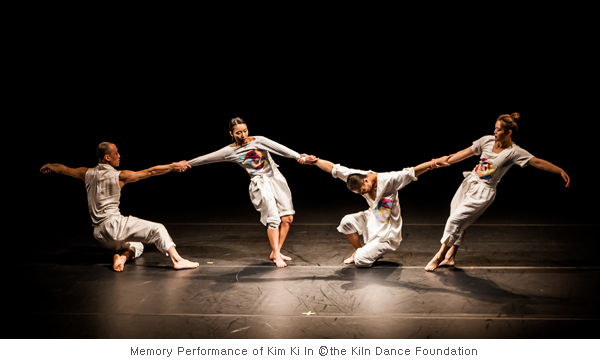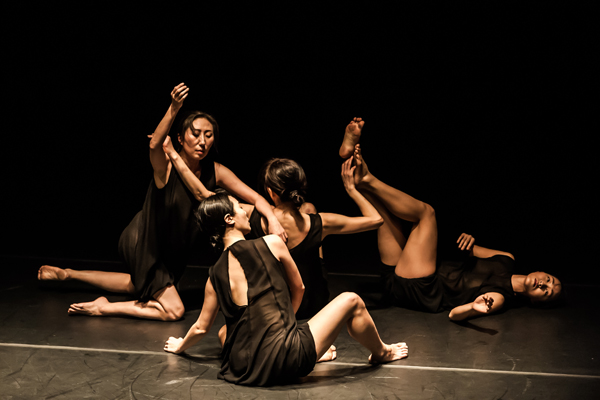|
A question that we who live ask ourselves rarely. It becomes the task of those who stay behind to grapple with our (artistic) legacy: to put it in order, to apportion it, and keep remembrance alive. Some have the time and the vision to control their bequest – like, for example, Merce Cunningham, who set a date after which his works shall no longer be performed. Others are torn from life and therefore cannot control what happens to their own assets. Then we cannot ask what is important for them to impart and communicate, which of their works should continue to live, rehearsed and danced by whom; we have to answer these questions ourselves.
This is the case with Kim Ki In, whose three-year memorial anniversary was observed on December fourth of this year with a commemorative performance in Namsan Art Theater in Seoul, initiated by the KiIn Dance Foundation. Kim Ki In died too soon, abrubtly, in the middle of her life. Shock and sadness were still keenly felt on this evening three years later. Many came who knew and loved her. Companions, dancers with whom she had stood on stage, colleagues, students and others – people with whom she joined in intellectual, spiritual and religious questioning.
I never knew Kim Ki In personally. I came to know her through a text by Kim Ki Sun, who welcomed the guests on this evening and spoke a few words about her sister. My Korean would not allow me to follow the speech, but judging from the reactions of those around me, it must have been moving and struck a nerve with the listeners.
For me, the highlight of the evening occurred at the very beginning. It was a film, which showed Kim Ki In in her element: dance. Poetically edited, rhythmically and cleverly cut, and interspersed with lines of text. Brilliantly artistically arranged by Yoon Mina, this film shows a person that glows with clarity and strength – a dancer with a strong aura, breathing freely, united with gravity while seemingly disassociated from it. As if in an unearthly atmosphere, she separates air from air with her long arms, creating three-dimensional space, without question and sure of herself – at once introverting and sweeping outwards, simultaneously connected to above and below, behind and forward. The center of her own cosmos that we observe and experience with her, that does not lock us out and yet only brings in those who would like to go.

Everything following the film – first of all One(meaning: wish) and secondly One(with the meaning: unity, a remake of the original choreography of Kim Ki In of 1984)– declined, could not help but become weaker. This was not because the choreography itself was weak, but because – yes, because Kim Ki In is not alive any more: she cannot dance herself, and she cannot set and rehearse her own choreography on other dancers.
The emotional connection of the dancers in the tribute, the remake of One, is so apparent, that something happens that the dancer Kim Ki In in the film so undogmatically refuses. Here, one does not have the freedom to decide; here, what one should feel is extracted – almost forced. A narrower, tainted space emerges, in which windows and doors are closed. We must, yes – we want to look inside! But only dancer Na Yeonwoo manages to produce a free and clear disposition while remaining connected to the content and her fellow dancers. The choice of Schubert Lieder as accompaniment, and above all the choice to present them with a live singer, is touching. But for me, who understood every word, the longings of Schubert's soul eventually became too romantic.
In the first choreography of the evening it is the two men who hang together in alignment between heaven and earth, pulling their energy from the earth, that pull the focus.
But there is more to Kim Ki In’s work than technical requirements; these must be met with inner maturity and awareness. Only then can the meaning of the timeless dance become perceptible: a dynamic game of strengths, a field of freedom beyond need and egotism, beyond the question of subjectivity and objectiveness. In One(wish) the dance and dancers are like planets, they circle each other, floating as if in outer space. They encounter each other on horizontal and vertical planes, lose each other again and generate a wave of energy that spills into the audience and weaves everyone and everything together.

Here it becomes clear what Kim Ki In meant with the title of the dance Seuseuro Tschum. It is not an essay on earthly themes, nor is subjectivity of artistic expression intended. Rather the piece is about dance itself, who in its presentation finds its origin, purpose and nature annihilated and overcome by itself – freely and without question in the cosmos, suspended like the stars themselves.
Seuseuro Tschum in pure presentation is a classic. Certainly a significant part of the history of contemporary dance development in Korea. But how can the future treat it fairly when she, who in the truest sense of the word embodied the work, is no longer here?
The KiIn Dance Foundation will continue to seek out possibilities to keep the work of Kim Ki In available in high quality and to pursue new paths after her wishes. May happiness be hers.
|






